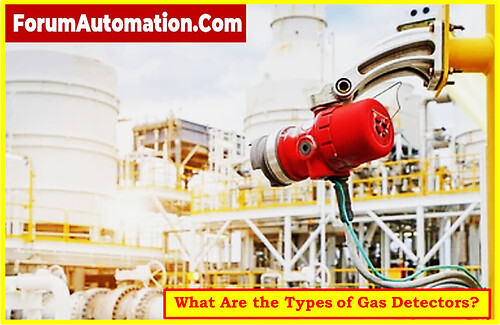- Gas detectors are critical safety equipment that detect the presence of potentially dangerous gases in a variety of situations, particularly in process industries where gas leaks are a problem.
- Gas detectors of various varieties use different sensing technologies to detect certain gases, assuring worker safety and preventing mishaps.
- Here are some examples of common types of gas detectors and their use in process industries:
Catalytic Sensors
- Catalytic sensors are used to detect combustible gases such as methane, propane, and hydrogen.
- They work on the basis of catalytic oxidation. A heated catalyst accelerates the reaction between the target gas and oxygen, causing the temperature to rise.
- These sensors are typically found in combustible gas-containing environments, such as oil refineries, gas pipelines, and chemical facilities.
Infrared Gas Sensors
- Infrared gas sensors detect hydrocarbons and carbon dioxide. They operate by passing a beam of infrared light across the test gas.
- These sensors are utilized in a variety of applications, including solvent recovery in paint booths, detecting refrigerant leaks in HVAC systems, and monitoring exhaust gases in combustion processes.
Electrochemical Sensors
- Electrochemical sensors are intended to detect toxic gases such as carbon monoxide, sulfur dioxide, and chlorine. Chemical reactions between the target gas and an electrode are used.
- Electrochemical sensors are frequently utilized in restricted areas, wastewater treatment plants, and hazardous chemical storage or processing regions.
Photoionization Detectors (PID)
- PID detectors are extremely sensitive to volatile organic compounds (VOCs) and other gases that can be ionized by ultraviolet (UV) radiation.
- These detectors can be used to monitor VOC emissions in chemical manufacturing, detect leaks in storage tanks, and ensure laboratory air quality.
Metal Oxide Semiconductor (MOS) Sensors
- MOS sensors are extremely adaptable and can detect a wide range of gases, including combustible gases and VOCs.
- They work by measuring changes in electrical conductivity caused by the interaction of a target gas with a metal oxide coating.
- MOS sensors are frequently used in semiconductor manufacturing, pharmaceutical manufacturing, and wastewater treatment plants.
Ultrasonic Gas Detectors
- Ultrasonic gas detectors are ideal for use in outdoor or open-air locations where gas leaks can occur across a large region.
- These detectors produce ultrasonic sound waves and are used in petrochemical plants, natural gas processing plants, and oil storage depots.
Open-Path Gas Detectors
- These devices are typically employed to detect gas leaks in vast open regions or along pipelines.
- They use a laser beam to track an established path.
- These detectors are useful in applications such as leak detection along natural gas pipelines and emissions monitoring in petrochemical complexes.
Chemical Warfare Agent (CWA) Detectors
- Chemical warfare agent (CWA) detectors are essential in defense and hazardous material management.
- To detect and identify chemical warfare weapons, they employ technologies such as colorimetric indicators and ion mobility spectrometry.
- These detectors are critical in military installations, chemical research laboratories, and other areas where hazardous chemical agents may be present.
Completion
- Gas detectors serve an important role in process industry safety by identifying gas leaks quickly, reducing the risk of fires, explosions, and toxic material exposure.
- The proper gas detector is determined by criteria such as the type of gas present, the environment, and regulatory requirements.
- Regular maintenance, calibration, and attention to safety regulations are critical to guaranteeing the effectiveness of these detectors in averting accidents and assuring personnel safety.
